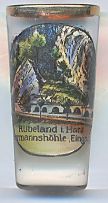

|
| DEUTSCHLAND | GERMANY |
| Bundesland: Sachsen-Anhalt | Saxony-Anhalt |
| Landkreis: Harz |
 Rübeland is situated at an elevation of 489 m on the river Bode in the Harz region of Germany's state of Saxony-Anhalt.
Bode is part of the municipality of Elbigerode (Harz).
Rübeland is situated at an elevation of 489 m on the river Bode in the Harz region of Germany's state of Saxony-Anhalt.
Bode is part of the municipality of Elbigerode (Harz).
The earliest written mention of To dem Rouelande dates from 1436. Located in the former duchy of Braunschweig-Lüneburg, the place became famous after the discovery in 1536 of a cave which later was named 'Baumannshöhle' after its discoverer, the miner Friedrich Baumann. The first guided tours for visitors were offered as early as 1649. In 1672 another cave, now named 'Bielshöhle' was discovered, the discovery of the 'Hermannshöhle' followed two centuries later, in 1866. In 1705 the region came in possession of the house of Hannover. After the annexation of Hannover by Prussia in 1866 it was at first part of the Prussian province Hannover and, together with Elbingerode, became part of the Prussian province Saxony in 1932. The Harz railway line (today named 'Rübelandbahn') between Blankenburg and Rübeland was opened in 1885. In 2004 the municipalities of Elbingerode, Königshütte and Rübeland were merged into the new municipality of Elbingerode (Harz). In the same year the predicate 'Höhlenort' ('cave town') was officially added to the the name Rübeland.
The  Hermannshöhle (Hermann Cave) [left] was discovered in 1866 and soon after was opened
to the public. The cave became also well-known for the many examples of bones of cave bears that were discovered in the cave.
Many, until then unknown, halls were discovered since 1970. Eighteen olms from Istria were brought to the cave in 1932 (5) and 1956 (13)
and were placed in an artificial lake. When in 1978 a breeding bassin was built, only male olms were found. The bassin was cleaned
in 1985, but again all 13 specimens that were caught were males.
Hermannshöhle (Hermann Cave) [left] was discovered in 1866 and soon after was opened
to the public. The cave became also well-known for the many examples of bones of cave bears that were discovered in the cave.
Many, until then unknown, halls were discovered since 1970. Eighteen olms from Istria were brought to the cave in 1932 (5) and 1956 (13)
and were placed in an artificial lake. When in 1978 a breeding bassin was built, only male olms were found. The bassin was cleaned
in 1985, but again all 13 specimens that were caught were males.
![[scale]](lineal.jpg)